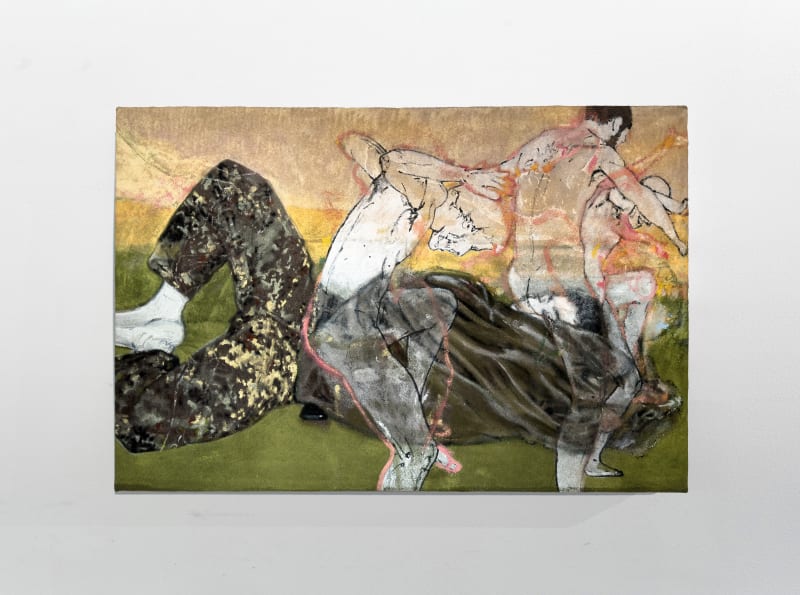Exhibition from July 8 to September 20, 2025
Closed from August 5 to September 1
ALEXANDRE FANDARD
MARIANA HAHN
GIOVANNI LEONARDO BASSAN
The gallery Les filles du calvaire invites curator Pierre El Khoury for a summer exhibition. Empreintes: from Gesture to Language brings together the work of Alexandre Fandard, Giovanni Leonardo Bassan, and Mariana Hahn.
"Everywhere, imprints precede or follow us. Many elude us, many disappear, sometimes before our very eyes. Some shine through, others stare us in the face. Some vanished long ago, yet something tells us they remain—buried, detectable through some archaeological detour of desire or method. At times, they seem to pursue us. Many will outlive us."
— Georges Didi-Huberman
We have all experienced the imprint. A foot in wet sand, a hand on a misted window: a single contact is enough for a shape to appear, a fleeting memory. But an imprint doesn’t merely testify that a body was once there. It is born of pressure, of friction, of passage. It implies a gesture which, when it becomes intentional—when it begins to signify—enters the realm of art.
The three artists brought together here — Alexandre Fandard, Giovanni Leonardo Bassan, Mariana Hahn — are not simply seeking to fix an image. Their work explores that moment when the body, in motion, leaves a trace. Engaging with the creative act not as a means of execution but as living matter, they cultivate incompleteness rather than fix form. What surfaces is less an image than a surge. The gesture is no longer a mere medium between idea and form: it becomes the very condition for appearance. And what remains, far from being just a relic, becomes a body in its own right — the artwork itself.
At the center of the exhibition space, a cube seems to replay the primordial cave. Not as decor, but as matrix: it is there that everything begins — in darkness, with the imprint of a body on the wall through a primal gesture. Alexandre Fandard does not use a brush. His tool is himself. He strikes, rubs, caresses, lacerates. He paints as one might summon ghosts. His works speak of wandering, of wrenching separation, and familial loss. Inspired by le Chien Fer, a soul ferryman in Martinican tradition, the three-legged creature becomes a totem-animal: a guardian who moves between worlds — limping, watching, resisting, crossing darkness with the slow resolve of those who know. Trained in dance and choreography, Fandard paints as one fights. Each impulse becomes a breath. His painting is a physical score. The body becomes a producer of meaning, not through representation but through action — through the trace it leaves, through the intuition it follows. Without premeditation or sketch, the artist lets an inner choreography emerge in which each movement resonates like a vital pulse. What he leaves behind is not a fixed work but the remnants of inner battles: the stigmata of a body traversed by History.
Memory, in the work of Giovanni Leonardo Bassan, is built through destruction. A painter and sculptor, he composes through repetition, erasure, and layering. He probes identity where it fractures — in its shifts and ruptures — making the canvas a field of tension where layers accumulate and contradict one another. Fed by the underground scene, Bassan develops a pictorial language that is restless and fluid. His works are palimpsests: inhabited yet always veiled, encrypted, caught in a dynamic of constant transformation. In his practice, the body emerges only to fragment again. This blurring is intentional: it obscures the identities of his subjects — friends, lovers, activists — to better preserve their mystery. Far from portraiture, he seeks what remains of a being: what drifts. In his recent formats — monumental triptychs, small works on military fabric, or bronze sculptures — the artist sculpts the surface as one might chisel skin. Hands become a recurring motif, an intimate obsession invoking an archaic language. Some pieces, even the painted ones, are treated as volumes: the layers dig into and collide with one another. Whether stencil or casting, the hand permeates his entire practice like imprinted flesh, a living imprint.
Mariana Hahn, finally, works within the invisible. Her creations appear gradually, like a secret spilling forth. Engraving, repeating, infusing: each piece is a sacred ritual. The word returns like a mantra, slowly shedding its primary meaning — like a body molting, extracting itself from its chrysalis. Name, this whispered word in some of her paintings, resonates like a silent invocation. In Sanskrit, nāma means both name and essence. It does not merely designate: it affirms a story, an embodiment, a passage. Hahn’s materials — hair, copper, salt — are conductors, acting as sensitive relays between the visible and the invisible. Through them, the body inscribes its memory in the obstinate repetition of gesture. The artist does not paint: she transmutes. Through this almost hypnotic choreography, a silent, organic language arises. Her deep blacks are breaches. Her vibrant blues are passages: lingering light, open veins on the canvas. Between the two lies a median space: that of emergence. In her introductory piece, one crosses this threshold. From shadow to light. From silence to form. From erasure to insistence. She does not offer a narrative to be read, but a language nurtured by murmurations — like a flock of birds and echoes.
And what if the imprint were a nascent form of language? André Leroi-Gourhan once reminded us: “Gesture precedes thought as the walker’s step precedes the goal.” From the dark cave walls to the gestures of these contemporary artists, what we read in the trace is not a frozen past, but the first momentum of a meaning to come. The work does not survive the body: it announces it.
— Elise Roche

